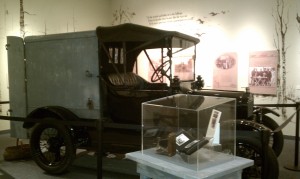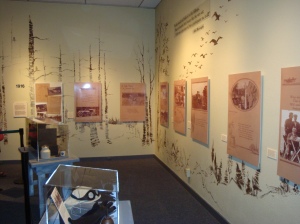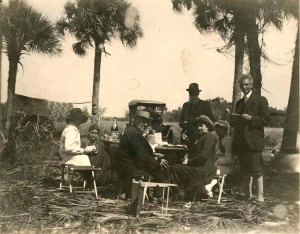by Chris Pendleton, President & CEO , Edison & Ford Winter Estates
Almost a hundred years ago, Thomas Edison and his good friend Henry Ford began a ten year exploration of America utilizing Ford’s new automobiles. In 1914 Edison, Ford, John Burroughs, and assorted family members assembled their Ford motor cars and embarked on a camping and exploratory trip of the Florida Everglades. It would begin a decade of exploration of America by the self-proclaimed ‘Vagabonds’ and the beginning of an unprecedented era of recreational travel that would transform America.
Edison had purchased riverside property in Fort Myers in 1885 and created a tropical retreat for himself, his family, friends and professional colleagues. By 1914 he was ready to explore Florida and to engage his colleague Henry Ford with his automobiles in the project.
In the winter of 1914, the respected American Naturalist, John Burroughs, and automobile magnate Ford arrived in Fort Myers to much fanfare and excitement to visit Edison. At the time Burroughs, the author of dozens of nature essay collections, enjoyed immense national popularity. Ford was at the height of his fame, having produced his self-coined “motor car for the multitude,” and instituted the previously unheard of – five dollar per day pay rate and eight hour workday.
Burroughs marveled at the exotic subtropical plants and birds of the Caloosahatchee River region, noting how much the area reminded him of Honolulu and Jamaica. Ford always looked forward to spending time away from his busy industry with his mentor and hero, Thomas Edison. Although we don’t know exactly how the idea for their first camping journey into Florida’s wild country came about, it seems likely that Edison saw the trip as an adventure and opportunity to share his beloved Eden with his friends.
However the idea materialized, the three famous men journeyed into the Everglades and investigated the flora and fauna of the Big Cypress area. Roughing it off-road in the Florida interior gave the men a taste for discovery. As a result, they, along with tire industrialist Harvey Firestone, embarked on a series of camping trips through the eastern United States.
For the next ten years, the “Vagabonds” and their guests explored America their way. They experienced the growing nation and its resources, as well as the interests of the American public, first-hand. They also engaged in tree chopping contests, entertained curious onlookers, motored off-road, and enjoyed time away from their busy lives. Yet the camping trips merit a deeper significance when observed against the backdrop of a period of tremendous political, technological, and industrial change.
According to Harvey Firestone’s reminiscences, each of the famous campers had a pre-described role in the trips. Edison arranged a storage battery set-up to light the camps and provide electricity. He also led late-night fireside discussions about politics, philosophy, and current events that became the hallmark of the trips. Firestone made sure the vehicles were loaded with provisions and hired the cooks.
Ford scouted out potential camping areas, often taking a swim in nearby waters, climbing trees, chopping wood with gusto, organizing contests for entertainment (rifle shooting, high kicking, and sprinting) as well as the role of caravan mechanic. Ford had two Model T trucks outfitted with drinking water tanks and work tables for the cooks. (One of these trucks is on display in the Edison & Ford Winter Estates Museum Exhibit “Into the Wild”).

Early RV: This chuck wagon was loaded up with food and supplies for the camping trips Edison and Ford took with their friends.
Burroughs was the philosopher and nature-lover on the trips. A good deal older than the other campers, he enjoyed the role of instructor, taught bird calls, shared his knowledge of botany, and led nature walks.
Over the decade in which the trips took place, they evolved from relaxing getaways to heavily promoted events that included numerous publicity stops covered by the press and the Ford Motor Company’s newsreel cameras. Historians often note that Edison’s greatest invention did not garner one of his famous 1093 patents; it was his propensity for self-promotion that may have been his utmost genius.
Similarly, Ford capitalized on his image as an “everyman” by using the camping trips as a means to promote the joys of recreational motoring, in turn, selling more Model Ts. It is no coincidence that tin-can tourism became the national rage at the same time that the “Vagabonds” highly-publicized camping trips took place.

Hunting was a popular pasttime on these camping adventures. Pictured here, is Henry Ford with a pheasant.
The fact that two sitting United States Presidents, Warren Harding and Calvin Coolidge made appearances during the camping trips, illustrating the influence that Edison, Ford, and Firestone wielded not just in business, but in politics.
Interestingly, the “Vagabonds” could not have chosen a more eventful decade to embark on their camping adventures. World War I ushered out the innocent turn-of-the-century era and heralded in the Roaring Twenties, a time that social, technological, and communication developments reached new heights.
From 1914 to 1924 the world experienced intense change, much of it wrought by the giants at the center of the camping trips. The affordability of the automobile, due to Ford’s assembly line production, changed America from an agrarian to an urban nation in a relatively short period.
Edison’s legacy was perhaps even more apparent by this time. The accessibility of electrical power in the 1910s and early 1920s increased intensely, and changed the way in which people lived, worked, traveled, and communicated.
Edison, Ford, and Firestone were keenly aware of the role of politics and international affairs in their business success. It seems likely that their earliest discussions on the quandary of rubber availability may have occurred near the campfire, leading them to the incorporation of the Edison Botanic Research Corporation (1927), headquartered in Fort Myers, Florida, with a goal of raising and producing an organic source of rubber in the United States thus relieving the nations dependence on foreign rubber.
The colorful outdoor adventures of the famous friends spanned more than a decade of American history and captured the imagination and attention of the public. The Vagabonds’ camping trips amounted to much more than a group of famous men cavorting across the countryside enjoying time away from it all; the trips were an adventure into a rapidly changing America, a venue for self-promotion and political influence, as well as a means of exploration and discovery in the midst of a time of great international change.

Into the Wild is a special exhibit at the Edison & Ford Winter Estates documenting the camping adventures of Edison, Ford and friends.
Today Thomas Edison’s estate and the neighboring estate of Henry Ford welcome hundreds of thousands of visitors a year, proudly displaying the original old cars and camping vehicles from the past century. The Edison & Ford Winter Estates is a National Register Historic Site and one of the top ten most visited historic homes in America. The property includes approximately 25 acres of historic gardens, a dozen historic buildings, a large museum full of artifacts and inventions and the original Edison Botanic Research Laboratory.
Additional information about tours, rentals and activities is available on the website at www.edisonfordwinterestates.org, or by calling the site at (239) 334-7419.
Chris Pendleton
President & CEO
Edison & Ford Winter Estates
2358 McGregor Blvd.
Fort Myers, FL 33901
www.edisonfordwinterestates.org




